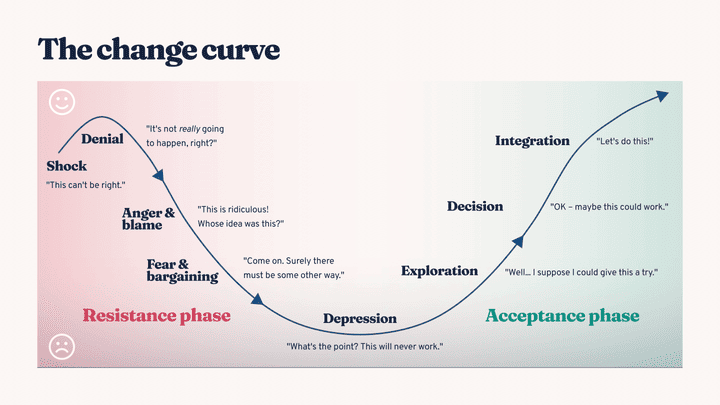Change impacts individuals and teams in unique ways. This article introduces a four-phase model of change and provides practical guidance on how to use it to support your team effectively during transitions.
The Process of Change
Adapting to change is often outlined as a structured process consisting of four key phases, as illustrated in the graph.
This “change curve” is influenced by Elisabeth Kübler-Ross’s research on the grieving process and further developed through Jacques Fradin’s insights into stress.

Why Change Can Be Intimidating?
When we understand the reasons behind change, we can often accept it and adapt by drawing on lessons from past experiences.
However, this is not always the case. When changes are sudden, drastic, or unclear, or when we lack understanding of the situation or direction, we may experience varying levels of stress throughout the change process before eventually reaching a new equilibrium.
Each stage of the process is linked to distinct emotions and behaviors. As a manager, supporting your team through change requires understanding where each member is on the change curve and responding with appropriate support.
Your Responsibilities as a Manager
It’s essential to approach the process with compassion and respect for the time individuals need to navigate each phase. Since everyone is different, managing changes that impact groups can be more challenging. As team members move through the curve at their own pace, you’ll need to adjust your management style to support each person’s progress effectively.
1. Inform
In this phase, it is crucial to be fully available for your team, actively listening and addressing their questions. Team members may feel surprised or confused, so create a safe space for them to express their feelings and share their opinions openly.
2. Explain
This phase focuses on providing clear context and helping the team understand the purpose of the change. Managers should articulate the need for the change, its potential impacts, and how it aligns with the team’s broader vision. It’s essential to remain firm on non-negotiable aspects while offering reassurance and guidance on how to move forward effectively.
3. Encourage
After individuals reach a level of acceptance, focus on motivating your team to embrace the change and work toward the desired outcome. Foster a safe environment, provide consistent encouragement, adopt a step-by-step approach, and celebrate small achievements along the way to build confidence and momentum.
4. Recognize
To sustain progress, focus on highlighting successes and what is working well. This reinforces momentum and keeps the team motivated. During this stage, it’s also important to embed the new practices into the corporate culture, ensuring the changes are firmly established and embraced by the team.
Conclusion
As a manager, you have the opportunity to support your team through the change process, making it easier for them to adapt. How might understanding the change curve model enhance your effectiveness in this role? Whether planning a change or navigating an unexpected one, consider leveraging the guidance of your coach to identify the best steps to manage and support your team effectively.